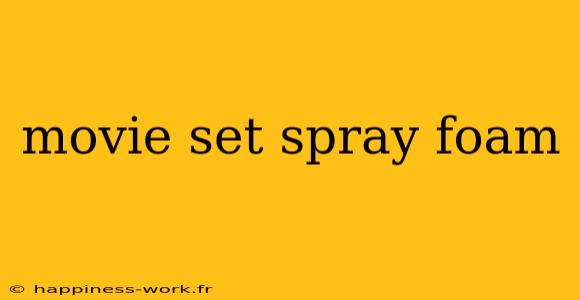Creating a believable world on a movie set requires meticulous attention to detail and the right materials. One material that has gained significant popularity in film production is spray foam. In this article, we will explore what spray foam is, its applications on set, and how it enhances the filmmaking process. We will also cover some tips and best practices for its use, ensuring you have a comprehensive understanding of this versatile material.
What is Spray Foam?
Spray foam is a type of insulation material that expands upon application. It consists of two components: isocyanate and polyol resin. When mixed, these components create a chemical reaction that causes the foam to expand and harden. This property makes it an excellent choice for various applications on movie sets, including building structures, creating special effects, and providing insulation.
How is Spray Foam Used in Film Production?
1. Creating Realistic Sets
One of the primary applications of spray foam in movie production is its use in building realistic set pieces. Whether it's simulating rocky landscapes, creating walls for a set, or even sculpting figures, spray foam allows set designers to easily manipulate forms and achieve a high level of detail.
Example:
In a sci-fi film, filmmakers might need to create an alien landscape. By using spray foam, the production team can sculpt intricate designs that resemble otherworldly terrain, which would be cumbersome to achieve using traditional materials.
2. Cost-Effective and Lightweight
Spray foam is a lightweight alternative to traditional materials like wood and plaster, making it easier to transport and assemble sets. This can significantly reduce labor costs, as less effort is needed to manipulate the material.
3. Insulation
Beyond its aesthetic uses, spray foam serves a functional purpose. It offers excellent insulation properties, which can be vital on set, particularly in extreme weather conditions. This insulation helps maintain a controlled environment for both actors and equipment.
4. Soundproofing
Another advantage of spray foam is its sound-dampening qualities. Filmmakers can use it to reduce noise transmission between different areas of the set, creating a better recording environment for audio capture.
Benefits of Using Spray Foam
- Versatility: Spray foam can be easily shaped and molded to fit the vision of set designers, allowing for creativity without constraints.
- Speed of Application: The quick application process makes it ideal for tight production schedules, ensuring that sets can be built rapidly.
- Durability: Once cured, spray foam is sturdy and can withstand wear and tear, making it suitable for use in high-traffic areas on set.
Best Practices for Working with Spray Foam
To maximize the benefits of spray foam on a movie set, consider these best practices:
- Safety First: Always use appropriate personal protective equipment (PPE) when working with spray foam, including gloves and respirators, to protect against fumes and skin irritation.
- Plan Your Application: Prior to spraying, have a clear plan of what you're creating. This can prevent waste and ensure the desired result.
- Temperature Considerations: Spray foam works best at specific temperatures. Ensure your workspace is adequately heated or cooled as needed before application.
- Proper Curing Time: Allow adequate time for the foam to cure before manipulating or painting it. This will ensure the best results and longevity of your set pieces.
Conclusion
Spray foam has revolutionized the way movie sets are constructed and managed. From creating detailed landscapes to providing insulation, its versatility and practicality make it a valuable tool in the hands of creative teams. As filmmakers continue to push the boundaries of storytelling, materials like spray foam will undoubtedly play an essential role in crafting the visual magic of cinema.
For further information on the topic, you can refer to the original discussions and insights provided by WikiHow, ensuring to give proper credit to their authors.
By implementing the tips and best practices outlined in this guide, you can effectively utilize spray foam on your next film project, enhancing both the creativity and functionality of your sets.
